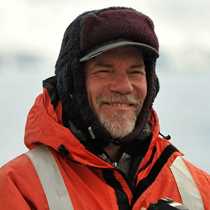At Sea, Cape Horn
The Antarctic is always surprising. Bright sunshine breaks suddenly from a dark grey overcast; whales appear without warning; howling gales descent out of quiet calm; one day’s misty sunset dissolves into the next morning’s glorious technicolor sunrise. If you let your expectations firm up a bit, if you grow just a little complacent, the Antarctic will throw you a curve ball that will leave you blinking and wondering what just went by. This week I was surprised by krill.
You might think that a marine biologist working in Antarctic seas would be unlikely to be startled by krill. They are one of the most important of all marine species in the Southern Ocean, a keystone species on which many other creatures depend. And, even though their numbers appear to have declined in recent decades, they are present in almost innumerable billions. But they usually occur in deep, open water, away from the rocky shores and muddy bottoms where I do most of my diving. In six years of diving these waters I have only seen krill a handful of times and even then it has been impossible to get good images of them with my video camera. They are very alert , they flee from any potential predator and they are FAST! So I have come to believe that really close sharp shots of krill are just unachievable.
Until a couple of days ago. Diving for the first time in the Berthelot Islands, south of the famous Lemaire Channel, I found a few large adult krill feeding close to a kelp-covered wall. Perhaps because they were already surrounded by waving fronds of kelp, these did not flee when I approached with my camera and I was able to shoot several minutes of top quality video. As far as I am aware, this is the best video EVER shot of krill in the wild. It was a real thrill that had me literally hooting into my regulator!
Later, showing the clips to our guests in the National Geographic Endeavour’s lounge, we were able to observe details of the krill’s anatomy and behavior that none of us had ever been able to see clearly before. Their strong swimming ability clearly derives from the beautifully coordinated action of their powerful pleopods (swimming legs), but even more amazing was the opportunity to observe the action of their periopods (feeding legs), which form a “feeding basket” with a pumping action that rapidly filters water and strains out their tiny phytoplankton food. It is this ability that allows krill to exploit the huge wealth of phytoplankton available in these freezing seas and, in turn, make this biomass available to feed the penguins, seals and whales of the Antarctic, giving krill the role we call a keystone species. What fantastic luck to be able to film this in action!
Keep your parka and binoculars handy; you never know what’s coming next.
The Antarctic is always surprising. Bright sunshine breaks suddenly from a dark grey overcast; whales appear without warning; howling gales descent out of quiet calm; one day’s misty sunset dissolves into the next morning’s glorious technicolor sunrise. If you let your expectations firm up a bit, if you grow just a little complacent, the Antarctic will throw you a curve ball that will leave you blinking and wondering what just went by. This week I was surprised by krill.
You might think that a marine biologist working in Antarctic seas would be unlikely to be startled by krill. They are one of the most important of all marine species in the Southern Ocean, a keystone species on which many other creatures depend. And, even though their numbers appear to have declined in recent decades, they are present in almost innumerable billions. But they usually occur in deep, open water, away from the rocky shores and muddy bottoms where I do most of my diving. In six years of diving these waters I have only seen krill a handful of times and even then it has been impossible to get good images of them with my video camera. They are very alert , they flee from any potential predator and they are FAST! So I have come to believe that really close sharp shots of krill are just unachievable.
Until a couple of days ago. Diving for the first time in the Berthelot Islands, south of the famous Lemaire Channel, I found a few large adult krill feeding close to a kelp-covered wall. Perhaps because they were already surrounded by waving fronds of kelp, these did not flee when I approached with my camera and I was able to shoot several minutes of top quality video. As far as I am aware, this is the best video EVER shot of krill in the wild. It was a real thrill that had me literally hooting into my regulator!
Later, showing the clips to our guests in the National Geographic Endeavour’s lounge, we were able to observe details of the krill’s anatomy and behavior that none of us had ever been able to see clearly before. Their strong swimming ability clearly derives from the beautifully coordinated action of their powerful pleopods (swimming legs), but even more amazing was the opportunity to observe the action of their periopods (feeding legs), which form a “feeding basket” with a pumping action that rapidly filters water and strains out their tiny phytoplankton food. It is this ability that allows krill to exploit the huge wealth of phytoplankton available in these freezing seas and, in turn, make this biomass available to feed the penguins, seals and whales of the Antarctic, giving krill the role we call a keystone species. What fantastic luck to be able to film this in action!
Keep your parka and binoculars handy; you never know what’s coming next.




